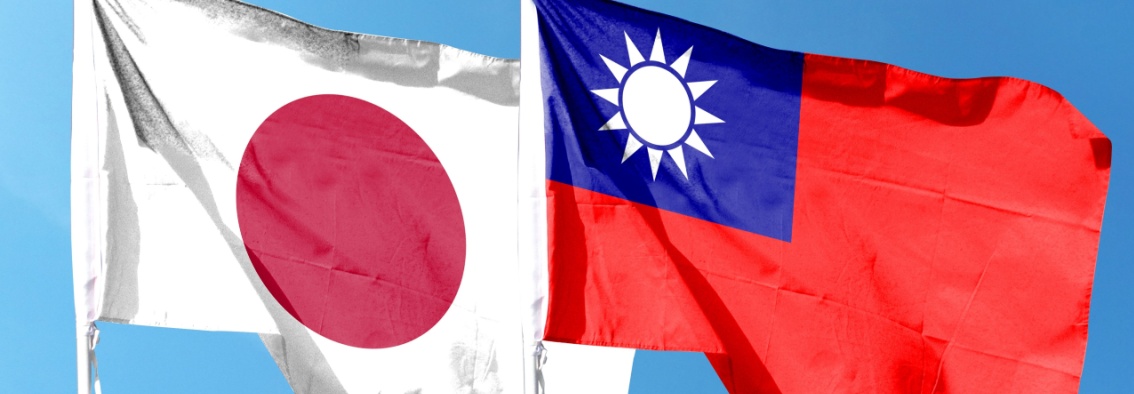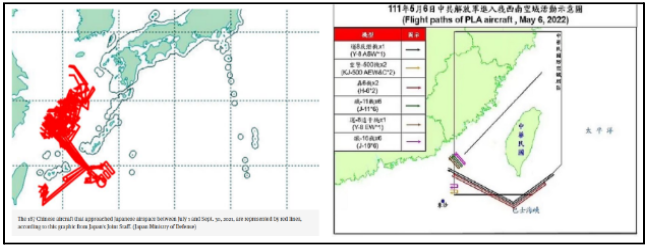Kizuna (bond), a concept as delicate as cherry blossoms yet as unyielding as Mount Fuji, beautifully embodies the spirit of Japan-Taiwan relations. This profound connection, forged in adversity and nurtured by mutual support, is woven with threads of shared experiences, empathy, resilience, and unspoken understanding. However, in the evolving landscape of geopolitics, this delicate fabric of kizuna now requires the steadfast reinforcement of a katana (the curved sword employed by Japanese samurai).
The rules-based international order, especially in the maritime sphere, faces unprecedented threats. Japan and Taiwan, both maritime nations, are committed to upholding the free and open Indo-Pacific. Both understand that security and prosperity hinge on maritime safety and vigilance. Both also recognize that maintaining consistency and stability in the open waters demands proactive engagement from geopolitically-aligned nations. However, despite their aligned goals and shared aspirations, Taiwan lingers on the periphery of Japan’s collaborative radar, with joint security initiatives remaining frustratingly sparse.
Japan’s “One-China Policy” walks a diplomatic tightrope, acknowledging Beijing’s stance while carefully navigating regional security challenges. This nuanced approach, rooted in the historical Potsdam Proclamation, is the main—but not only—obstacle to strong security collaboration with Taiwan at the governmental level. Tokyo, keenly aware of potential geopolitical ripples, acts with extreme caution. It meticulously avoids any action that might provoke Beijing or give Beijing a reason for retaliation. However, this delicate balancing act often takes precedence over the urgent need for strategic dialogue and cooperation with Taipei on critical security issues. As Beijing increasingly interprets any interaction with Taipei as tacit support for the island’s independence, these carefully drawn lines in the sand are rapidly eroding, rendering Japan’s cautious stance increasingly precarious and unsustainable.
Increasing Concerns in the Space and Maritime Domains
Japan finds itself confronting a paradox: its greatest security challenge, as per official documents, is the very nation it seeks to appease. China’s maritime forces—comprising the People’s Liberation Army Navy (PLAN), Chinese Coast Guard (CCG), and maritime militia—have been probing the waters around the disputed Senkaku Islands with increasing boldness and frequency. Simultaneously, in the space domain, China’s satellite capabilities are rapidly expanding in both scale and sophistication, reinforcing the importance of space as a critical domain in modern warfare. The recent space-related amendment to Article V of the US-Japan Security Treaty, crafted during the July 2024 US-Japan Security Consultative Committee (“2+2”), highlights Japan’s growing concerns about space security.
In an era of heightened geopolitical tensions, individual national efforts have become inadequate. The persistent presence of the CCG around the Senkaku/Diaoyu Islands, along with their bold maneuvers in the Taiwan Strait and East China Sea, has severely strained Taipei and Tokyo’s resources, leaving their leaders facing complex decisions. Compounding this diplomatic crisis, Chinese illegal, unreported, and unregulated (IUU) fishing fleets increasingly encroach upon coastal waters, threatening the livelihoods of seaside communities. This multifaceted challenge not only undermines Japan’s sovereignty and economic stability, but also jeopardizes Taiwan’s international standing and administrative legitimacy. As these issues grow more intense and diverse by the day, the isolated strategies of the past have become outdated. The message is clear: a new approach to cooperation isn’t just beneficial—it is pressing.
At the same time, Ukraine’s Starlink deployment should serve as a wake-up call for Taiwan and Japan. Taiwan and Japan need to develop similar backup systems using low Earth orbit (LEO) satellites, which have proven valuable in enhancing communication resilience when conventional systems fail. The fragility of undersea cables, often severed by Chinese vessels even in peacetime, combined with Japan’s reliance on Taiwan-adjacent networks, underscores the urgent need for robust, unassailable communication channels. Communication systems, as the “eyes and ears” of military hardware that enable sensing and targeting, rely on the seamless integration of sea cables, base stations, and geostationary satellites. In the event of war, maintaining communication within and beyond Taiwan is crucial for sustaining operations and mobilization. These critical components must work in perfect synchrony to facilitate efficient information exchange, command dissemination, and the coordination of international aid during times of conflict.
Taiwan Creates “Space” for Cooperation
To position itself optimally for modern warfare, Taiwan has increasingly focused on space technology as a key asset. The Taiwan Space Agency (TASA, 國家太空中心) and the Ministry of Digital Affairs (MODA, 數位發展部) have spearheaded this initiative, supported by industrial groups like the Taiwan LEO Satellite Industry Alliance (TLEOSIA, 台灣低軌衛星產業聯誼會). A significant milestone was achieved in July when MODA announced complete low and medium Earth orbit satellite signal coverage for Taiwan and its outlying islands. This network ensures that the island’s military can maintain communications, even if ground-based systems fail during a conflict. Concurrently, TASA is guiding Taiwan’s journey towards self-reliance in LEO satellite technology. Taiwan’s “National Space Technology Development Long-term (B5G) Plan,” launched in 2019, marks the third phase of this initiative. With a substantial investment of NTD $25.1 billion (USD $836.8 million) over a decade, plus an additional NTD $40 billion (USD $1.25 million), Taiwan aims to accelerate its space program. Key objectives include developing low-orbit communication satellites, establishing a national launch site, and nurturing local talent—an ambitious space endeavor indeed.
Wu Jong-shinn (吳宗信), TASA’s visionary director-general, has painted a picture of a future where Taiwan’s prized industries—cutting-edge semiconductor chips and a robust ICT ecosystem—will converge to revolutionize the LEO satellite bus. This key spacecraft component, which includes essential systems from power to navigation, is set to become smaller, sleeker, and much more efficient. [1] While the Japan Aerospace Exploration Agency (JAXA) may boast a decade of experience and a budget that dwarfs that of TASA, Taiwan’s strategic prowess in this burgeoning orbit sector sets the stage for potential collaborations between Taiwan and Japan—a partnership that would leverage both countries’ technological strengths.

Image: An image of Camano Island in the state of Washington (USA), taken by the Japan and Taiwan jointly-developed “ONboard Globe-Looking And Imaging Satellite” (ONGLAISAT), launched in 2024. The ONGLAISAT program is an example of the increasing cooperation by Japan and Taiwan in the space domain. (Image source: CNA / Taiwan Space Agency)
A Dual-Function Cooperation Architecture
Leveraging the distinct strengths of both Japan and Taiwan to fortify robust maritime and space domain cooperation is essential. The oft-quoted phrase “Taiwan’s contingency is Japan’s contingency” underscores Tokyo’s imperative for a versatile cooperative framework. By marrying economic and security interests with situational flexibility, such a “dual-function” paradigm serves multiple purposes: fortifying security, bolstering economic stability, and safeguarding citizen welfare. Like a masterfully crafted katana, this approach embodies both elegance in peacetime and readiness for potential challenges.
Enhancing Coast Guard and LEO Cooperation Programs
A dynamic cooperative model that is seamlessly adaptable to both peace and conflict, akin to an “on-off switch,” is urgently needed between Japan and Taiwan. Beyond enhancing shared security and prosperity, maritime and aerospace ventures introduce a crucial deterrent factor to Chinese aggression. By establishing a cooperative framework for real-time information sharing, the two states’ shared agility to respond swiftly and effectively to emergencies is fortified, creating a stronger defense against potential security threats. Moreover, these two areas are less provocative than some other areas of security cooperation, while still maintaining the potential to ignite economic growth, drive innovation in maritime and space technologies, attract investments, generate employment, and foster technological advancement.
The confluence of these factors underscores the critical imperative of elevating coast guard and LEO satellite cooperation to the agenda. Two compelling reasons exist to prioritize these initiatives on the cooperative’s agenda. First, while joint efforts in coast guard activities and LEO satellites are in progress, they lack momentum. In coast guard collaboration, formal steps have been taken: memoranda of understanding (MOUs) have been signed and personnel assigned. However, these measures have not yet been implemented as practical on-site training or joint exercises. As of now, cooperation between the frontline personnel in both nations has been limited to humanitarian crisis communications and paper drills. Still, given that these areas of cooperation already have an established foundation, advancing upon agreed-upon cooperation is more feasible when compared to starting from scratch in other domains.
Second, in light of Tokyo’s current position on cooperation with Taipei—and Tokyo’s reluctance to do anything that might provoke Beijing—fortifying partnerships with Taiwan in less sensitive, yet dual-purpose domains is a viable strategy. Collaboration on coast guard operations and low earth orbit (LEO) satellites aligns strategically, with both countries sharing an interest in developing Maritime Domain Awareness (MDA) and Space Domain Awareness (SDA). Therefore, these identified areas not only enhance mutual defense capabilities, but also contribute to humanitarian efforts and drive technological advancements for both nations.
Bring Kizuna into Reality
In its latest National Security Strategy, Japan paints a stark picture: “We live in the world of a historical inflection point and in the face of the most severe and complex security environment since the end of WWII.” This clarion call demands not just acknowledgement, but a symphony of action. Tokyo and Taipei must weave a tapestry of cooperation in times of peace, lest they be forced to hastily stitch together alliances in the crucible of crisis. The time has come to exchange whispers of prevention, rather than shouts of preparation.
The main point: Despite aligned security goals between Taiwan and Japan, Tokyo’s reluctance to take actions that might provoke Beijing limits potential cooperation. Because joint efforts on coast guard activities and LEO satellite development are areas in which Taiwan and Japan already have signed MOUs—and because both serve the dual purpose of contributing to humanitarian efforts and enhancing technological advancements—this could be a potentially less sensitive way to cooperate, and should be prioritized by Taiwan and Japan.
[1] Author’s interview with TASA’s director-general in July 2024.





